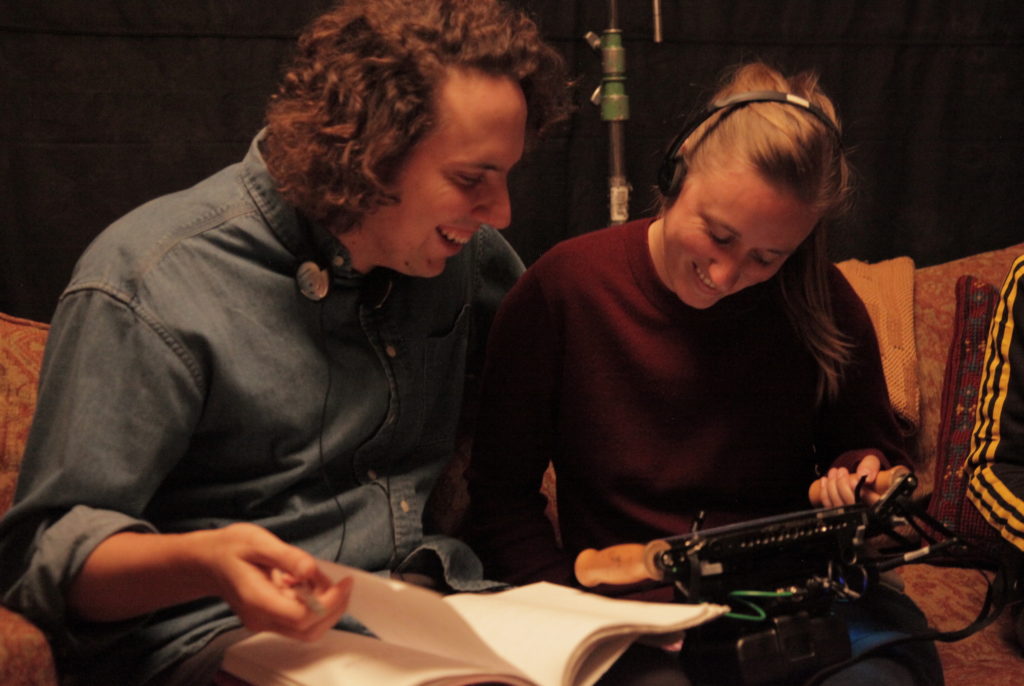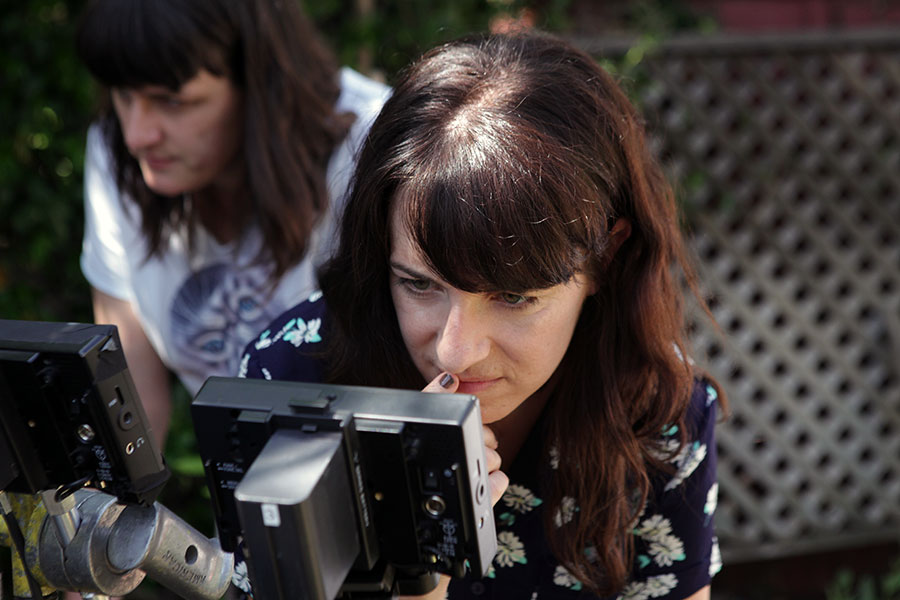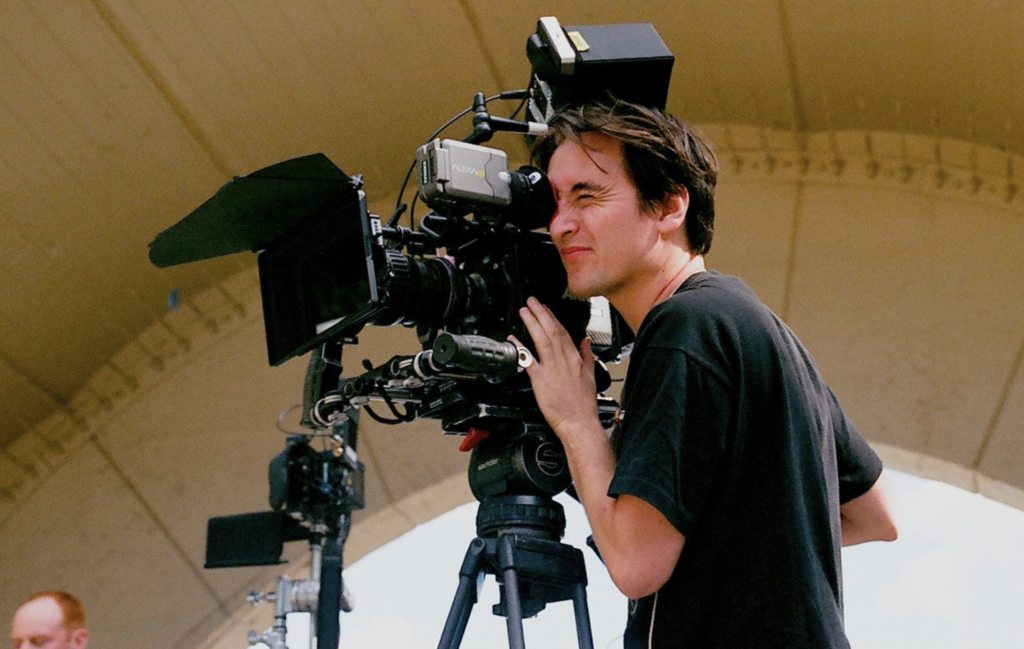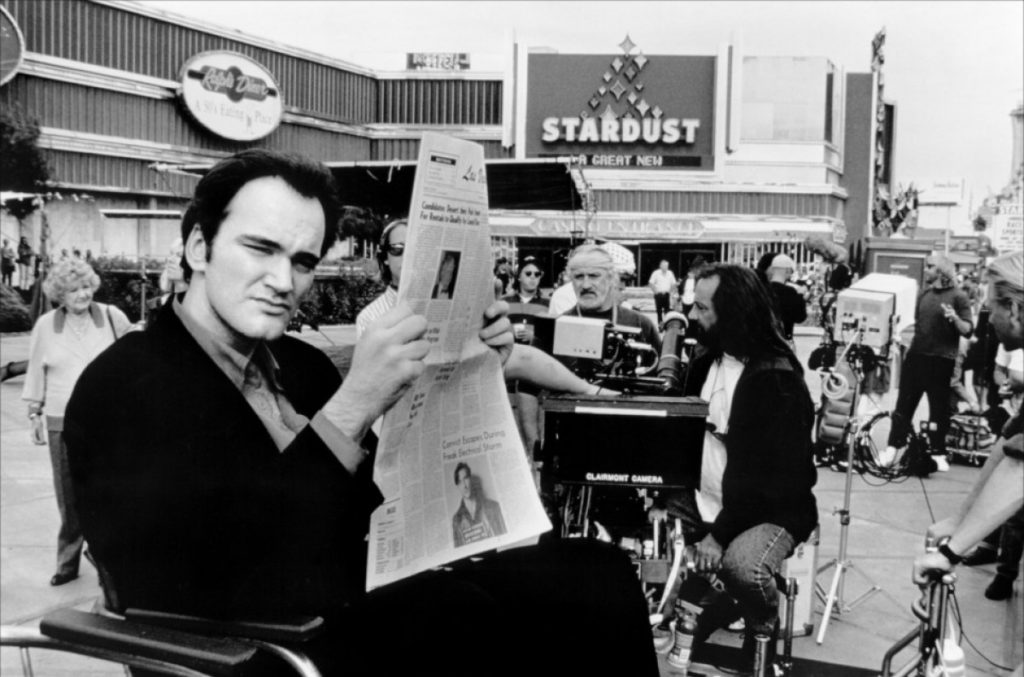When it comes to filmmaking – and perhaps also surviving an earth-shattering emergency – teamwork is key. ALEX H. FISCHER and ELEANOR WILSON both had directing careers of their own before they decided to expand their real-life partnership and into a filmmaking partnership. The result – SAVE YOURSELVES!, a sci-fi comedy about a couple working together to stay alive – arrives at as perfect a time as possible. Before this collaboration, Australian actor/filmmaker Wilson had achieved success directing the short films Everything All At Once and Low Road; and writer/director Fischer was best known for commercials, shorts, and music videos before making his feature debut Snowy Bing Bongs Across the North Star Combat Zone with co-director Rachel Wolther, which landed him as one of Filmmaker Magazine‘s 25 New Faces of Independent Film in 2017.
In Save Yourselves!, Brooklyn couple Su (Sunita Mani) and Jack (John Reynolds) decide to put away their phones and laptops and have an unplugged getaway at an isolated cabin upstate. Su looks forward to re-grounding their relationship and Jack is ready to perfect his sourdough recipe (yes, really), but unbeknownst to them, furry alien creatures have landed on Earth and started decimating New York. Save Yourselves! premiered at the 2020 Sundance Film Festival (where Alex and Eleanor co-hosted the SAGindie Filmmaker Luncheon), just before the country actually started isolating itself for its own global crisis.
Acquired by Bleecker Street Media, Save Yourselves! arrives in theaters on October 2, and on digital platforms on October 6. We spoke with co-writers/directors Eleanor Wilson and Alex H. Fischer about their feature debut as collaborators, how they’ve stayed productive in quarantine, and how they made the perfect “pouffe.”
——
COLIN McCORMACK: So this is your first project together. Was this the impetus to you teaming up, or had you already decided you wanted to start working together and then you came up with the idea?
ALEX H. FISCHER: It was the idea first.
ELEANOR WILSON: Yeah, it was the idea first and then it just seemed right as a thing for us to work together on.
AHF: Eleanor writes and directs, she’s made her own shorts and has her own features that she works on too, and this was one that I guess she felt would be fun to do together. So it was her idea and she asked me if I would be interested in writing it together and I was like, “Yeah!”
EW: I had made a tiny little comedy, but this just seemed like a great crossover of the types of things we like and it just worked out, luckily. We’re still a couple!
CM: Did you come up with a game plan before production on how you’d divvy up the on-set responsibilities?
EW: We talked about it a little bit and we had said, for the most part, we both want to be involved in every aspect and we didn’t like the idea of dividing and conquering. So we just stuck with that and it worked out. The good thing about having two directors is that we have talked through absolutely every possible thing before we get to set because we have had to hash it out between ourselves. Also naturally as directors, we like to prepare a lot, so any time we got to set it was kind of a one-brain-two-bodies situation.
AHF: The other benefit was we lived in the location in the cabin, the two of us, so before and after we moved out there we would block stuff out and use our iPhones. “Eleanor, go into the yard and stand there. Okay, ten feet to the left. Okay, now fall.” We would block out these shots so by the time we got to the shoot, we didn’t have to figure it all out, because on indie movies you have to move kind of fast.
EW: There was one day where we did split up a little bit more just out of necessity because there were so many things we were trying to achieve in one day. So I think it was that day where I was mostly talking to the actors and Alex was mostly doing the technical things. But for the most part, we both had a hand in all of it and that’s how we like to work together.
CM: Eleanor, since you have a background in acting, does that influence the way you work with the actors you’re directing?
EW: Definitely, yeah. I think it’s nice to know what it’s like to be on that side of things. I guess a slight difference in our strengths is I am always looking at a scene and think of it from the emotional logic point of view and I think that’s helpful in being able to explain what you’re trying to get across to the actors without going into line-readings. You can talk about the subtext or what’s behind the line.
AHF: Whereas I just go in there all line-reading [laughs].
EW: No, that’s not true! I think also those are some of the most fun days for me, where there were a couple of scenes that get a little more dramatic. It was really fun to work with the actors on those scenes, because so much of the comedy stuff, they’re just running rampant and killing it and then obviously there are certain aspects where it’s more difficult performance-wise.
AHF: Yeah, there are some more dramatic moments in there.
CM: When you guys were writing, were you writing in the same room at the same time or switching off scenes? What was the collaboration process in the writing?
AHF: I think we did everything together then too. We really didn’t split up too much in the drafts.
EW: Yeah, I think there were certain things where you’d be like, “I’m on a roll with this, so I’m just going to write this thing out.” We work in a program that’s live, so we’re on two computers working on the same document.
AHF: It’s called WriterDuet. Like Google Docs but for scripts.
EW: It refreshes live so we can see what the other person is writing, so we can literally write over the top of each other and delete things we don’t like.
AHF: That was key, to each have our own laptops so you don’t feel like you’re out of control.
EW: Not hovering over someone’s shoulder.
AHF: Because when someone else is writing, they’re at the control there and you’re just standing watching them type something and it’s just hell [laughs]. So we didn’t have to do that.
EW: We had our own control stations. We do that with everything, even just working on pitches or this or that, we only do it on live documents for that exact reason, so there’s not only one person dominating because that would be infuriating.
AHF: I think Apple should come out with a control station for laptops.
EW: Just called Control Station?
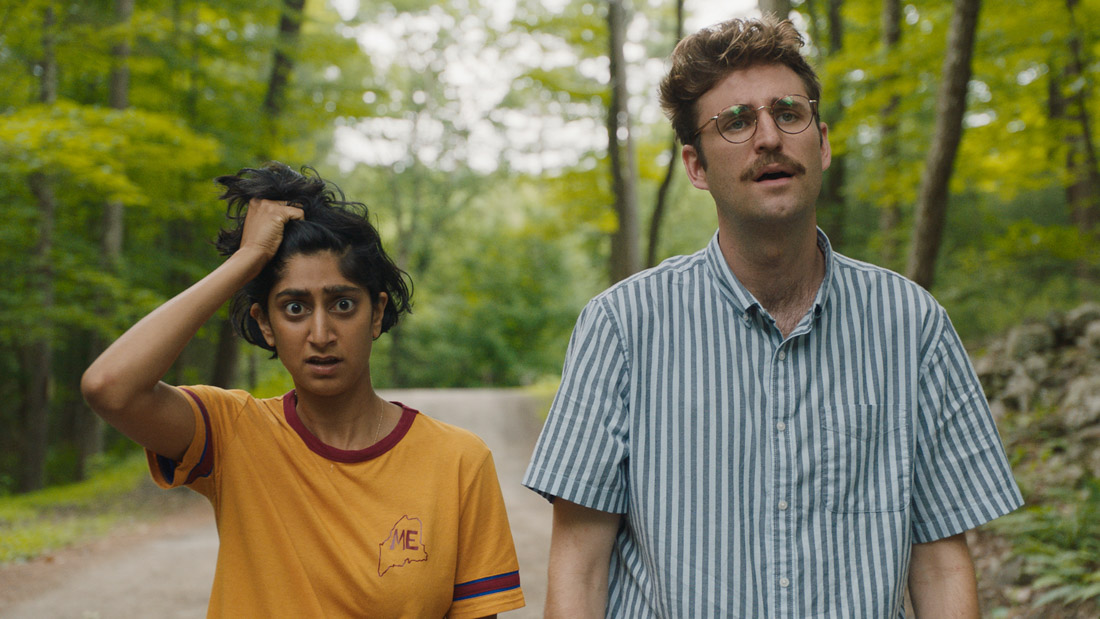
CM: You wrote the role of Su for Sunita, correct?
EW: Yeah, that’s why she’s called Su, we never changed it. Alex went to college with her and they’ve known each other for a long time and have worked together a bunch. We just think she’s so funny and charming and we really wanted to cast her in a lead role in a feature. And we’re lucky that she liked it. We didn’t let her in on the plan for a while.
AHF: You never know! We’re dear friends, but she could have been like, “Uhh…”
CM: Yeah, I was curious about that. At what point do you tell someone, “Hey, I wrote something with you in mind?” It’s got to be a little scary.
AHF: Yeah, ’cause then if they say no, you don’t want them to feel bad about it either.
EW: And you want to remain friends.
AHF: So we wrote the script. We never told her we wrote it for her until we were shooting it. Even though the character’s name is Su.
EW: I think it was maybe around the third big draft when we sent it to her. It developed even further after that, but once you have the actors in mind, it becomes fun to do a new pass at the script in their voice. We shared it with her probably a little more than a year before we shot it. She was on-board pretty much right away from that. And John we had seen in Search Party and just really loved him.
AHF: He was perfect. And we thought they were the perfect couple in the movie. They were everything we wanted.
EW: John we didn’t have a direct line to, so you go through the manager and do the whole thing to get the script to him. And then we had [Save Yourselves! co-star] John Early put in a good word for us because they worked together on Search Party. Then we had a meeting with [Reynolds] and we thought he was so wonderful. It was obvious.
AHF: He just felt funny. He can be hilarious and can also nail the emotional stuff.
EW: But after we’d gone through these correct professional avenues, we then later found out that [Sunita and John] know each other and we probably could have just gone straight to him [laughs]. But that was just another moment, that they already knew each other. I think a lot of the draw for John was that Sunita was involved and he could see what the tone of the project would be based on the fact that he knows her comedy and her taste. So I think it felt like a safe environment for them because they knew each other.
CM: What was the moment where it went from something you guys were working on on your own to something that had gotten a green light and was moving forward to becoming a reality?
AHF: It’s funny, the “green light.”
EW: It’s never a singular moment.
AHF: It’s more like a door is opening and then you never know where the next door is going to be [laughs]. We originally wrote it to be a smaller movie and we thought we could raise a little bit of money. Then we met certain people and we started thinking we could maybe get a little more and pull off something bigger.
EW: It’s still a very small indie movie. We met the producers who came on board as the main financing producers, who found the rest of the financing, probably nine months before we shot it. So considering that, it came together really quickly, but we’d already been working on trying to find financing by ourselves for a year before that.
AHF: Flailing for a year. It’s funny, our financing producers at Keshet and Washington Square Films actually met up at Sundance the year before we [screened], so two years ago, basically. And they cheers’d and said, “See you next year at Sundance!” as a joke.
EW: Then it happened! Yeah, it’s very hard [because] we live with the assumption that anything can fall apart and any moment because it can.
AHF: Even after you finish it.
EW: So we never truly celebrated until I think after–
AHF: After we finished post. Then we had a drink at a bar in Brooklyn.
EW: Yeah, the day we finished post we had some champagne. Like, “I guess we can celebrate now?” In pre-production there was never a specific green light moment, it was just, Okay, we’re location scouting. Okay, there are people here in an office now. I guess this is all happening.
AHF: Now we’re signing a contract. When do we celebrate?
CM: Like you were saying, it’s still a small film. Were you able to have time or money for rehearsals?
EW: Yeah, we had about a week before we shot. It was sort of a combined time of rehearsals and wardrobe fittings and that kind of thing. John and Sunita both enjoy coming to each day pretty fresh in-the-moment, so our rehearsal was really more like talking through the script and talking through the characters.
AHF: We very thoroughly talked through the script.
EW: Just identifying like, “Is there anything in this scene that’s weird to you?” “Would you say this differently?” That kind of stuff.
AHF: It was actually like a feedback session. Because even though we’re friends with Su, she’s very busy so we hadn’t really sat down with the script. So on the first day, we were going through the script and they just gave us their thoughts on the characters. Then we adjusted it the week before we shot a couple of things. It was great. It was really helpful.
EW: Whatever that rehearsal looks like, just having time set aside to spend with your actors is so invaluable. Even if it’s just sitting and talking about nothing, even if you just go to lunch, it’s just nice talking and building a relationship and figuring out how they’ll work together.
AHF: We also asked them what they hate. Like what is it directors do that you hate usually. I’m trying to think of what they said-
EW: I feel like John had a good one. Like when you do a thing and then the director gives you a direction that you did already.
AHF: Yeah. He’s like, “Don’t do that.”
EW: Noted.
CM: In those cases when it’s a smaller film, the talent that everybody brings is almost just as important as the vibe they bring to the set in terms of personality. That’s a little harder to gauge in a normal job interview setting, but things seemed to work out on that end?
EW: Absolutely. We got so lucky with the crew and everyone involved in this. We were talking about it the other day, from the producers down to every PA and every day player who came on, we were just so lucky. And also since John and Sunita got along with the crew really well, that was such a helpful thing to have. Because I guess it doesn’t always happen and it can be a tense environment because the days are long and you’re working very quickly and sometimes in tight spaces and sometimes in hot spaces because you can’t turn the AC on while you’re shooting or whatever. It can be a bit of a pressure cooker environment, but we were very lucky that everyone was calm and nice and good people.
AHF: The tone of the set was really important to us the whole time. We made sure to bring people on – heads of departments – that we thought we would get along with and we thought would be fun to work with. That was one of the most important things for us in finding the heads of departments because then it all trickles down into their departments.
EW: John and Sunita also both are so funny that between every single take, one of them would always be cracking a joke to make the whole crew laugh, and that is such a gift to be given on your set, to have comedians on set every day.
AHF: Everyone should hire standup comics.
EW: Even when times were stressful, John would have this natural tendency to make people laugh [to make] people feel comfortable. For us, it was such a benefit that they were funny and the crew would laugh and everything would seem a little bit easier.
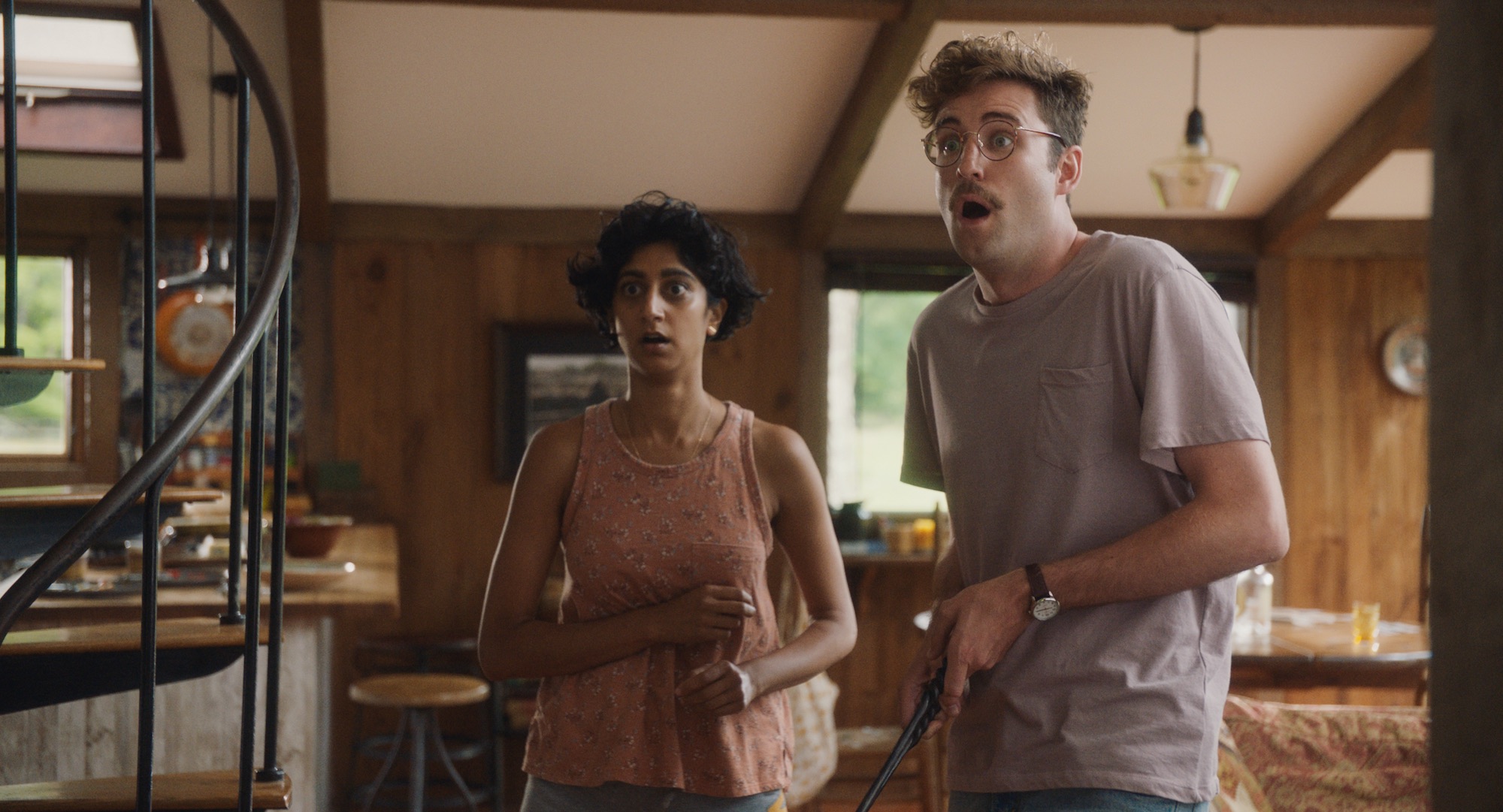
CM: In location scouting for the cabin, were you looking for something more that matched what you were envisioning aesthetically, or were there specific practical amenities that the location needed for the production itself?
EW: Both. We were very lucky that we got all of that in the location we had. We knew we needed a pond and a barn and we obviously wanted the cabin to look really beautiful. We didn’t expect that we’d be able to find all of those things in one location, so that was huge. I guess in terms of the cabin itself, we wouldn’t have chosen an ugly cabin if it had a barn and a pond on it. We would have figured out how to split that up because the aesthetic is very important when you spend so much time in that one location. It’s got to be just varied enough and visually interesting enough that you don’t get sick of looking at it for most of the movie. But yeah, we got a place that had a great pond that was full of tadpoles. Many little tadpoles that turned into many little frogs.
AHF: A billion tiny frogs.
EW: And it had a really awesome barn and some private woods that we shot some stuff in as well. So it was great to have all that centralized. It was two-and-a-half full weeks where we were only at the cabin. That was the first stuff that we shot and it was a real luxury to not have to move around.
AHF: We got lucky. The most important thing is what’s going on screen, so we wanted something that was cinematic and felt right. And it had this sort of vulnerability with this whole wall of windows. But production is very important to an indie film, so we were also very conscious of the logistics. And this particular cabin that we found, the actual front door is on the other side of the cabin and there was a main road that led to a driveway where we could put the production van. When [John and Sunita’s characters] pull up to the cabin, that’s actually the back of the cabin and where they’re pulling up from is just nothing. Just a dirt road to nothing.
EW: Yeah. Throughout the whole shoot, behind the cabin was a couple of trucks and a huge tent for everybody to eat in, but you can’t see any of that.
AHF: The cabin blocked it. And the road was sort of below us, so when cars went by you couldn’t see it either.
EW: I have a bit of a production background, so just knowing what you lose when production has to move, it’s a struggle. It does end up on the screen because you end up having less time when you have to move. So being able to walk 30 feet to the lunch spot every day saved us so much.
AHF: The production office was in the garage, there was another room that we didn’t use for the movie. What a great cabin.
CM: What city was it in?
EW: It was in a town called Krumville, New York, which is about 20 minutes from Woodstock. Most of the cast and crew stayed around Woodstock, where they had restaurants and nice amenities and so on.
AHF: And each department head had their own house, so it was kind of like summer camp and they hung out practically every night and every weekend. Tatiana [Bears], our line producer, scheduled activities. It was really fun; roller-skating, tie-dying, they almost went zip-lining.
EW: But we vetoed that. [Laughs] Nobody hurt yourselves!
CM: Yeah, the insurance company would be thrilled to hear you canceled that one.
AHF: Yeah.
CM: What was the production schedule? You said two-and-a-half weeks at the cabin, but what was the total?
EW: The total was 22 1/2 days. We spanned over Fourth of July Weekend, so we had four days off.
AHF: It was really nice, actually.
EW: It was perfect. So in between going from Upstate to when we shot in Brooklyn last, we had those four days off, which was really good. So sort of five weeks, but 22 1/2 days.
CM: In terms of the “pouffes,” were they written as pouffes from the first draft, or did that visual style of the species evolve over time?
EW: That was in the first draft, they never changed from that. We wanted it to be something that could be in the cabin that they didn’t notice for a while until it starts moving. So that was where the idea for that came from. Then obviously once you go down the rabbit hole of the history of furry aliens in cinema, it’s fun to be a part of those movies.
AHF: Yeah, in the script it was a pouffe from the beginning. And our mood board or imageboard for the movie was gerbils, Critters, the furry version of Gremlins, stuff like that. Then the real fun was we actually tried to make it. Eleanor actually designed and hand-stitched the pouffes. A lot of what we were trying to figure out first was what fur to use for it. Gerbils are little furballs but they have directionality to the fur and we wanted our fur to stick straight out. So we thought about electrifying it-
EW: [Laughs] Static.
AHF: But that was impossible. So we ended up finding in LA’s Fashion District these really cool special feathers on a boa, which Eleanor wrapped around a dome and then stitched it to a dome.
EW: And then Calder [Greenwood], who was our visual effects supervisor, we pretty much fashioned them to be like a shower cap and pulled it over different mechanisms that he would make. So depending on what the pouffe needed to do, he had different tricks in the guts of it.
AHF: There’s this one shot where the pouffe does something and there’s probably four different skeletons for the pouffe for each shot in like a one-second sequence.
CM: And you don’t have a background in puppetry or anything like that?
AHF: No, I did take a puppetry class in college.
EW: You did?
AHF: I did. For me, I watched a lot of YouTube videos and read a lot about behind-the-scenes on how special effects are done. It’s really fun to try to get to do it.
EW: Yeah, that part of it. We had two weeks with Calder in LA before we went to New York for pre-pro, which we called “Pouffe Lab.” And Pouffe Lab was so fun. Just getting to focus on one aspect of the movie really intensely and figure out what are the different cool things we can get these things to do, it was a joy.
AHF: We got to play with forced-perspective with some things. A lot of old movie tricks. Played with the background. We had a lot of fun with it.
CM: What was post-production like for you, not only working on your first feature together but one that had some visual effects components to it?
AHF: Well, that was one of the good things about doing so much practically and in-camera was that [post] was pretty easy. A lot of it was built-in. We did do a lot of very subtle visual effects, but we had a lot of these assets in the footage. We worked with a visual effects supervisor – who is a director and a friend of ours – who is not a visual effects supervisor as a profession, he’s a director. We convinced him over the course of a couple drunken nights that he had to do it. So the whole team was only five people spread all over the world. In Italy. In LA.
EW: One was in Luxembourg.
AHF: It was a very indie feel in post as well.
EW: It was great and that’s how we wanted to do it. Because we had shot so much of it practically, it really helped with the edit as well because Sofi [Marshall], our editor, was working while we were shooting. So the first week we would do this crazy pouffe sequence and say, “Hey, can you focus on just doing an assembly of this so we can see what it looks like and make sure that we’ve got it?” So that was really helpful doing that overlap approach there. Then in general with the storytelling, she didn’t have to imagine what the VFX are going to look like.
AHF: It’s a pouffe.
EW: All it’s ever going to be beyond what you’re seeing in the footage is just slightly enhanced. It meant we could really figure out the pacing in the edit and not have to worry too much about what that extra layer is going to do to the feeling of it.
AHF: One of the funny things is Sofi was in New York and we were in LA and this was obviously pre-lockdown, but we edited the whole thing remotely over Zoom.
EW: There were a couple times where we went back to New York and we sat with her for a day. And it was really fun to hang out, but mostly we were on Zoom.
AHF: We were like, “This is working out great! We don’t have to stand over her.” It was a really wonderful, collaborative process.
EW: Yeah, highly recommend. Even though now everyone’s going to have to do that anyway.
CM: You premiered at Sundance right before the pandemic hit, but coming out of the festival, what were your plans for the film? Did you have a festival tour lined up; had you already landed a distributor?
EW: All of that. We were going to be playing SXSW as well, which we were so excited about because we’d never had a film there before. It unfortunately got canceled like three days before the event I think. And there were a few other festivals lined up and Bleecker had just come on board officially maybe a couple weeks before SXSW.
AHF: One of the perks of getting into Sundance – which is such a gift – is you get invited to other countries to play at their festivals and they pay for your flights and hotels. That would have been a real treat [laughs].
EW: It would have been a fun year of traveling.
AHF: Instead, we were locked in our apartment. But we were much more productive than we would have been.
EW: For sure. It’s been a productive few months. And we’ve been Zooming into Q&A’s. It has been playing in some countries that have figured out their corona situation and have theaters open again.
AHF: They just won’t let us go. We’re unclean.
EW: Also we’re really loving this drive-in revival. It’s really fun.
AHF: Yeah, and [Save Yourselves!] feels like a good drive-in movie.
CM: Yeah, I saw Bleecker put out that retro trailer, which really amps up the vibes of an old drive-in movie.
EW: Yeah totally, we loved that trailer.
AHF: We should do a whole re-edit of the movie like that in black-and-white.
EW: It’s funny, I wonder if people will somehow only see that trailer and wonder, “What the hell is this?”
CM: You said you’ve been productive during this time of quarantine. There seems to be two camps: The people who are really productive and the people who feel guilty for not being super productive. How did you guys land in the productive camp?
EW: I would say mostly we’ve been productive. Because we haven’t gone anywhere or done anything else, we’ve just been here. And because there’s two of us, it’s a little bit easier to stay motivated. I think if I was doing this by myself I’d have fallen into a bit of despair by now [laughs].
AHF: Definitely.
EW: We’ve managed to only have one of us freaking out at any given moment. And it’s been a great time to watch old movies.
AHF: Yeah, just watching movies and writing and doing our best to get involved.
EW: Right, with activism. We’ve been writing a lot of postcards.
CM: Same here. Any movies that stand out that you wanted to shout out that you’ve seen?
EW: I loved She Dies Tomorrow. We’ve seen some fun things at the drive-in. We saw She Dies Tomorrow and The Rental and Palm Springs. Basically all the new movies that have been playing at the drive-in. And all of these really would make great double-features with Save Yourselves! The Rental is another cabin movie.
AHF: We also found one really fun thing to do, which is to watch documentaries with the Documentary Now! episode that makes fun of them.
EW: We’ve been doing a lot of that. Highly recommend that.
AHF: The War Room, Jiro Dreams of Sushi.
EW: The Sondheim doc [Original Cast Album: Company].
AHF: As a double-feature, or a one-and-a-half feature, it’s really fun.
CM: To wrap things up, what’s next for you guys?
EW: We’ve got a few things. We’re writing a book adaptation that we can’t really give any specifics on.
AHF: It’s very different. It’s not a sci-fi-romantic-comedy, it’s a family [story].
EW: We have a couple directing things to do when directing is a job again one day [laughs].
AHF: They’re all in a different place. Eleanor and I work together and we also like to work separately; we also like to write stuff we’re not directing and direct stuff we’re not writing, so it’s sort of all over the place, which is what we like.
EW: This has definitely been a good time to write and be creative right now.
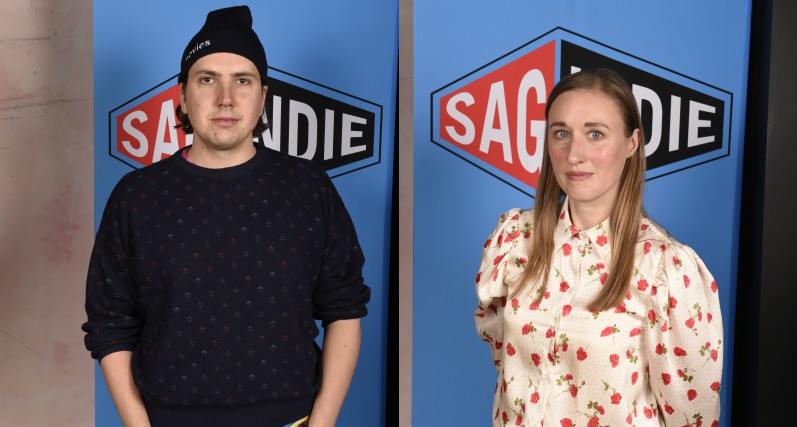
__
Thanks to Eleanor and Alex for talking to us about SAVE YOURSELVES!. Learn more about the film at saveyourselvesmovie.com or follow the film on Facebook, Instagram, or Twitter.
This interview has been edited for clarity.
If you’re an independent filmmaker or know of an independent film-related topic we should write about, email blogadmin@sagindie.org for consideration.

